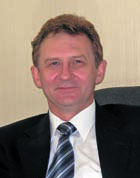| His Coordinates, Interviews | |
New GNSS will cause a synergetic effect and not chaos
|
|||||||
Glonass system is an element of the critical state infrastructure. please elaborate this statement?GLONASS is a dual-use system, which is applied to meet the needs of national security, as well as of the economic growth in various branches of Russian economy, including transportation, communication, energy, and mining, i.e. in those areas, which constitute the background for the economic strength of Russia. What stage is Glonass now?At present we are working on the modernization of the GLONASS system using Glonass-M space vehicles. It is expected that the full orbital constellation will be deployed in 2010 and the system performance characteristics will be improved. This will lay the foundation for the large-scale implementation of GLONASS both in Russia and abroad. Use of Glonass is the binding in russia for the governmental users and critical applications. pl. comment?In 2005 The Government of Russia adopted the Resolution № 365, enacting the obligatory use of GLONASS across Russia. This mainly concerns the governmental users and the users from the key strategic branches of the Russian economy. This requirement has been anchored by the Presidential Decree of May 18, 2007. At present weare completing the legal base formation to implement the taken decisions. At the same time, there are no restrictions imposed on the use of other systems, provided that the user equipment is sure to use the GLONASS signals along with the signals of other systems. What about Glonass availability to users in entire globe?At the moment we have the routine replacement of the old Glonass space vehicles by the new Glonass-M. By the end of 2008 the GLONASS orbital constellation is expected to comprise 18 operational satellites, and the continuous navigation across Russia will be provided. As for now, the combined use of GLONASS and GPS provides the reliable and continuous navigation even in the city jungles. What are your modernization plans?We are planning to enhance the level of performance characteristics, to develop the GNSS augmentations, electronic maps of the required scale and coverage, competitive user equipment and the essential preconditions for its mass production, and to implement the pilot projects of the GLONASS use in various areas. The GLONASS modernization plan suggests the introduction of new navigation signals for the civil users, including those with the code division. How do you see GLONAS vis-à-vis US GPS and Europe’s Galileo?The GLONASS modernization plan implies the activities to achieve compatibility and interoperability of signals, geodetic frames and time systems of all existing and perspective GNSS. They all will operate together, but each will remain under national control. How much conflict or compatibility you see among these GNS?We do not see any conflict among GLONASS, GPS and Galileo, COMPASS. All compatibility issues shall be resolved within ITU coordination procedure. On the contrary, as I have already emphasized, we see that in future these GNSS will complement each other for the benefit of users throughout the world. What about international cooperation of GLONAS with country like India?We have a really close cooperation with India in the field of satellite navigation. There is an intergovernmental agreement on cooperation in this sphere, covering the joint efforts in the GLONASS development, as well as in the augmentations and user equipment issues. Our common task is to make this agreement work. Countries like India, China, Japan aspire to have their own GNS. Are we heading for a GNS chaos?We are convinced that the emergence of the new GNSS will cause the synergetic effect, rather than chaos, for they will operate together and complement each other in a mutually beneficial way. In this respect, much is expected of the International Committee on GNSS, established following the United Nations General Assembly resolution. It seems to me, that the main task of this Committee in terms of the GNSS providers would be the development of the common “GNSS gaming rules”. Thus the consumers worldwide will gain substantial advantage from the combined use of all systems, primarily through the enhanced reliability of navigation. Do you think of a scenario when there in one Global Satellite Navigation System for all?We are progressing toward combined united GNSS where each system will operate independently under national control. Thus, I believe we will succeed to provide compatibility and interoperability of all systems to benefit all users over the world and all applications.
| |||||||













 (No Ratings Yet)
(No Ratings Yet)




